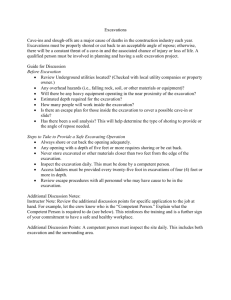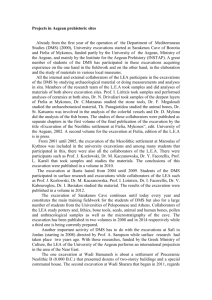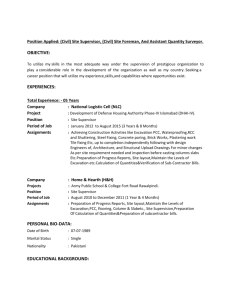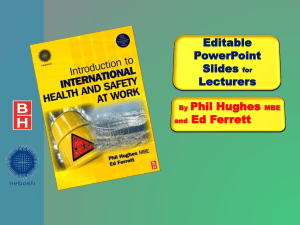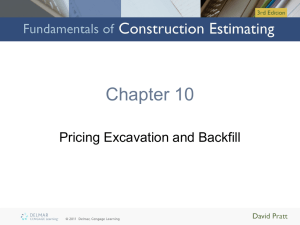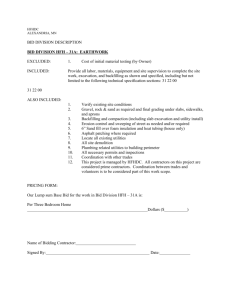Excavation and Trenching - League of Minnesota Cities
advertisement
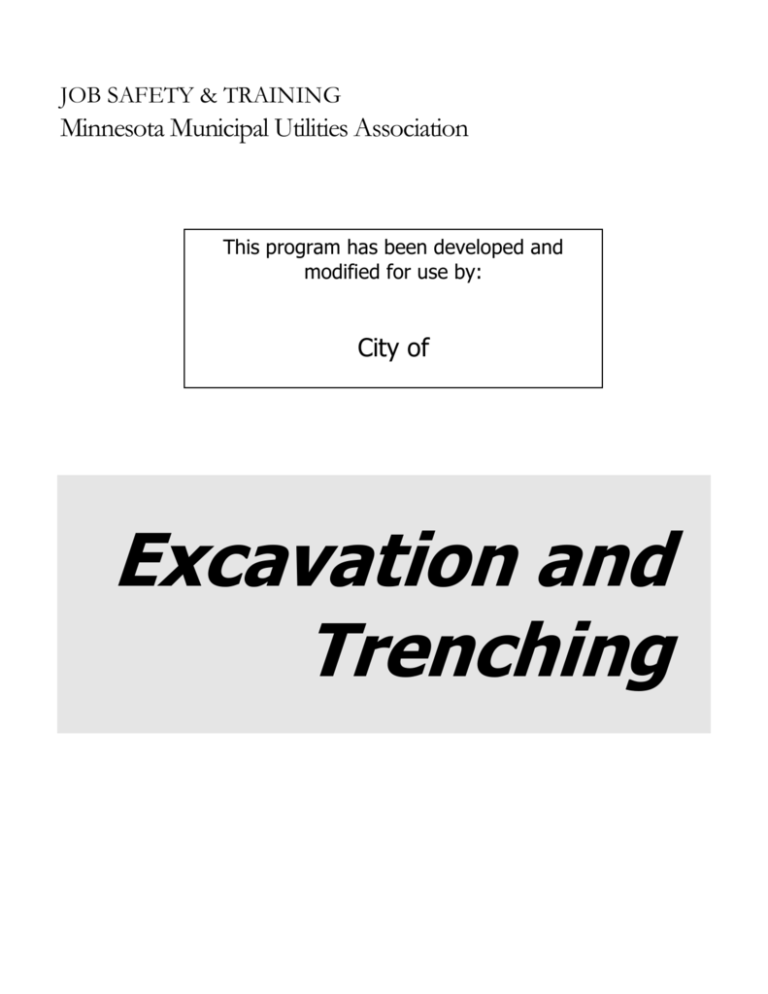
JOB SAFETY & TRAINING Minnesota Municipal Utilities Association This program has been developed and modified for use by: City of Excavation and Trenching MINNESOTA MUNICIPAL UTILITIES ASSOCIATION Excavation and Trenching Manual Minnesota Municipal Utilities Association 3025 Harbor Lane North • Suite 400 Plymouth, MN 55441-3859 Phone 763.551.1230 • Fax 763.551.0459 www.mmua.org 1 PURPOSE T he purpose of this program is to provide written policies and procedures that are to be used by City/Utility personnel to safely and effectively perform excavation and trenching activities. The intent of this program is to comply with the Occupational Safety and Health Administration (OSHA) Excavating and Trenching standard (29 CFR 1926.651). SCOPE This manual applies to all excavation and trenching operations. An excavation is defined as any man-made cut, cavity, trench or depression in an earth surface formed by earth removal. A trench is defined as a narrow excavation (in relation to its length) made below the surface of the ground. In general, the depth is greater than the width, but the width of a trench (measured at the bottom) is not greater than 15 feet (4.6 m). If forms or other structures are installed or constructed in an excavation so as to reduce the dimension measured from the forms or structure to the side of the excavation to 15 feet (4.6 m) or less (measured at the bottom of the excavation), the excavation is also considered to be a trench. POLICY All excavation and trenching operations shall be conducted in accordance with the procedures and practices established in this manual. AVAILABILITY A copy of this manual shall be available at all excavation job sites. 2 WORK PLANNING GENERAL REQUIREMENTS All excavation and trenching operations shall be pre-planned to identify and control: Potential job site hazards. The impact of the work on normal operations and public activities. SMALL SCALE OPERATIONS Pre-job briefings conducted by the competent person (and including all affected employees) shall be used to plan and coordinate small scale excavation operations. LARGE SCALE OPERATIONS Large scale/long-term excavation and trenching operations that will affect the general public shall be planned and coordinated with all affected local departments. Project planning shall: A. Define the scope, nature and length of the project: B. Identify and evaluate potential hazards associated with the job site: C. Impact on normal operations. Access to public and private buildings. Impact on vehicular traffic and parking. Impact on pedestrian traffic. Impact on public and private landscaping. Underground utility lines. Overhead electrical lines. Undermining of adjacent surface structures. Vehicular hazards to workers. Soil properties and characteristics. Conditions that might result in a hazardous atmosphere. Conditions that might result in the inflow or accumulation of water. Other job site safety and health hazards. Identify job site protection and traffic control requirements. 3 D. Identify the most feasible cave-in protective system (e.g., sloping, shoring or shielding). E. Identify a job site competent person. The general public shall be notified in advance of all major excavation operations. JOB SITE OPERATIONS COMPETENT PERSON A competent person shall be designated for excavation job sites. The competent person shall be capable of identifying existing and predictable hazards in the surroundings or working conditions which are unsanitary, hazardous or dangerous to employees, and shall have the authority to take prompt corrective measures to eliminate them. The competent person shall be responsible for: Conducting soil tests to determine appropriate means of protection. Specify the means and methods necessary to control recognizable hazards. Coordinating the placement and relocation of shoring and shields. Conducting air testing as dictated by job site conditions. Conducting job site inspections. Conducting tailgate job briefings and safety talks. Only employees that have been appropriately trained shall be authorized by the City/Utility to serve as competent persons at excavation job sites. Employees that have received said training shall have listed below has the duty and authority to take all measures necessary to protect the safety and health of employees working at excavation and trenching operations. 4 JOB SITE INSPECTIONS Daily inspections of excavations, the adjacent areas and protective systems shall be made by a competent person for evidence of a situation that could result in possible cave-ins, indications of failure of protective systems, hazardous atmospheres or other hazardous conditions. An inspection shall be conducted by the competent person prior to the start of work and as needed throughout the shift. Inspections shall also be made after every rainstorm or other hazard- increasing occurrence. These inspections are only required when employee exposure can be reasonably anticipated. The competent person shall inspect the job site to: Identify any signs of sidewall collapse or failure. Evaluate the effectiveness/condition of the protective system. Evaluate the effectiveness/condition of methods used to support undermined structures. Evaluate the effectiveness/condition of methods used to support exposed utility lines. Evaluate the effectiveness/operation of dewatering equipment. Evaluate the appropriate placement of spoil piles. Evaluate the effectiveness/condition of barricades. Evaluate the appropriate use of personnel protective equipment. Identify and remove from service damaged/defective tools and equipment. Evaluate the placement/condition of ladders/ramps. Evaluate the adequacy/availability of emergency equipment. Identify any atmospheric hazards within the excavation by conducting appropriate tests when dictated by job site conditions. Identify and correct any other condition, situation or event the affects employee safety and health. Where the competent person finds evidence of a situation that could result in a possible cave-in, indications of failure of protective systems, hazardous atmospheres or other hazardous conditions, exposed employees shall be removed from the hazardous area until the necessary precautions have been taken to ensure their safety. 5 JOB SITE PRACTICES A. Surface Encumbrances All surface encumbrances that are located so as to create a hazard to employees shall be removed or supported, as necessary, to safeguard employees. Surface encumbrances include but are not limited to: Retaining walls and fencing. Sidewalks. Trees. Power poles. Rocks. Other objects that could become unstable and create a hazard to employees. B. Underground Installations The estimated location of utility installations, such as sewer, telephone, fuel, electric, water lines or any other underground installations that reasonably may be expected to be encountered during excavation work, shall be determined prior to opening an excavation. Utility companies or owners shall be contacted within established or customary local response times, advised of the proposed work and asked to establish the location of the utility underground installations prior to the start of actual excavation. When utility companies or owners cannot respond to a request to locate underground utility installations within 24 hours (unless a longer period is required by state or local law) or cannot establish the exact location of these installations, the employer may proceed, provided the employer does so with caution, and provided detection equipment or other acceptable means to locate utility installations are used. One Call Number Gopher State One Call 1-800-252-1166 Or 811 Or www.gopherstateonecall.org/eticket When excavation operations approach the estimated location of underground installations, the exact location of the installations shall be determined by safe and acceptable means. While the excavation is open, underground installations shall be protected, supported or removed as necessary to safeguard employees. 6 C. Access and Egress Structural ramps that are used solely by employees as a means of access or egress from excavations shall be designed by a competent person. Structural ramps used for access or egress of equipment shall be designed by a competent person qualified in structural design and shall be constructed in accordance with the design. Ramps and runways constructed of two or more structural members shall have the structural members connected together to prevent displacement. Structural members used for ramps and runways shall be of uniform thickness. Cleats or other appropriate means used to connect runway structural members shall be attached to the bottom of the runway or shall be attached in a manner to prevent tripping. Structural ramps used in lieu of steps shall be provided with cleats or other surface treatments on the top surface to prevent slipping. A stairway, ladder, ramp or other safe means of egress shall be located in trench excavations that are 4 feet (1.22 m) or more in depth so as to require no more than 25 feet (7.62 m) of lateral travel for employees. o Appropriate care and caution shall be used when using metal ladders in the vicinity of overhead and/or underground electrical lines. o Ladders shall extend at least 3 feet above the ground surface and shall be secured in place. o Each day before being used, ladders shall be inspected for damage or defects. Additional inspections shall be performed during use, where service conditions warrant. Portable ladders with structural defects, such as, but not limited to, broken or missing rungs, cleats or steps; broken or split rails; corroded components; or other faulty or defective components, shall either be immediately marked in a manner that readily identifies them as defective or be tagged with "Do Not Use" or similar language and shall be withdrawn from service until repaired. D. Exposure to Vehicular Traffic Before work that may endanger employees is begun in the vicinity of vehicular or pedestrian traffic, warning signs or flags and other traffic control devices shall be placed in conspicuous locations to alert and channel approaching traffic. Work zone protection and traffic control devices shall comply with Part VI of the Manual on Uniform Traffic Control Devices, U.S. Department of Transportation, Federal Highway Administration. Where additional employee protection is necessary, barricades shall be used. Warning lights shall be prominently displayed at night. Employees exposed to public vehicular traffic shall be provided with, and shall wear, warning vests or other suitable garments marked with or made of reflectorized or highvisibility material. 7 E. Exposure to Falling Loads No employee shall be permitted underneath loads handled by lifting or digging equipment. Employees shall be required to stand away from any vehicle being loaded or unloaded to avoid being struck by any spillage or falling materials. Operators may remain in the cabs of vehicles being loaded or unloaded when the vehicles are equipped, to provide adequate protection for the operator during loading and unloading operations. F. Warning System for Mobile Equipment When mobile equipment is operated adjacent to an excavation or when such equipment is required to approach the edge of an excavation and the operator does not have a clear and direct view of the edge of the excavation, a warning system shall be utilized such as barricades, hand or mechanical signals or stop logs. If possible, the grade should be away from the excavation. G. Hazardous Atmospheres To prevent exposure to harmful levels of atmospheric contaminants and to assure acceptable atmospheric conditions, the following requirements shall apply: Where a hazardous atmosphere exists or could reasonably be expected to exist, such as in excavations in landfill areas or excavations in areas where hazardous substances are stored nearby, the atmospheres in the excavation shall be tested before employees enter excavations greater than 4 feet (1.22 m) in depth. Hazard Minimum Allowable Conditions Oxygen Not less than 19.5% and not more than 23.5%* Flammables Less than 10% of the lower flammable limit* Carbon Monoxide Less than 35 ppm Hydrogen Sulfide Less than 10 ppm No employee shall enter an excavation that contains a known or suspected hazardous atmosphere. When controls are used that are intended to reduce the level of atmospheric contaminants to acceptable levels, testing shall be conducted as often as necessary to ensure that the atmosphere remains safe. Emergency rescue equipment, such as breathing apparatus, a safety harness and line or a basket stretcher, shall be readily available where hazardous atmospheric conditions exist or may reasonably be expected to develop during work in an excavation. This equipment shall be attended when in use. Air testing devices shall be calibrated and maintained in accordance with the manufacturer’s recommendations. 8 H. Bell-Bottom Pier Holes Employees entering bell-bottom pier holes or other similar deep and confined footing excavations shall wear a harness with a lifeline securely attached to it. The lifeline shall be separate from any line used to handle materials and shall be individually attended at all times while the employee wearing the lifeline is in the excavation. I. Protection from Water Accumulation Hazards Employees shall not work in excavations in which there is accumulated water or in which water is accumulating unless adequate precautions have been taken to protect employees against the hazards posed by water accumulation. The precautions necessary to protect employees adequately vary with each situation, but could include special support or shield systems to protect from cave-ins, water removal to control the level of accumulating water or use of a safety harness and lifeline. If water is controlled or prevented from accumulating by the use of water removal equipment, the water removal equipment and operations shall be monitored by a competent person to ensure proper operation. If excavation work interrupts the natural drainage of surface water (such as streams), diversion ditches, dikes or other suitable means shall be used to prevent surface water from entering the excavation and to provide adequate drainage of the area adjacent to the excavation. Excavations subject to runoff from heavy rains will require an inspection by a competent person. J. Stability of Adjacent Structures Where the stability of adjoining buildings, walls or other structures is endangered by excavation operations, support systems such as shoring, bracing or underpinning shall be provided to ensure the stability of such structures for the protection of employees. Excavation below the level of the base or footing of any foundation or retaining wall that could be reasonably expected to pose a hazard to employees shall not be permitted except when: A support system, such as underpinning, is provided to ensure the safety of employees and the stability of the structure; or The excavation is in stable rock; or A registered professional engineer has approved the determination that the structure is sufficiently removed from the excavation so as to be unaffected by the excavation activity; or A registered professional engineer has approved the determination that such excavation work will not pose a hazard to employees. Sidewalks, pavements and appurtenant structures shall not be undermined unless a support system or another method of protection is provided to protect employees from the possible collapse of such structures. 9 K. Protection of Employees from Loose Rock or Soil Adequate protection shall be provided to protect employees from loose rock or soil that could pose a hazard by falling or rolling from an excavation face. Such protection shall consist of scaling to remove loose material, installation of protective barricades at intervals as necessary on the face to stop and contain falling material, or other means that provide equivalent protection. Employees shall be protected from excavated or other materials or equipment that could pose a hazard by falling or rolling into excavations. Protection shall be provided by placing and keeping such materials or equipment at least 2 feet (.61 m) from the edge of excavations or by the use of retaining devices that are sufficient to prevent materials or equipment from falling or rolling into excavations or by a combination of both if necessary. L. Fall Protection Walkways shall be provided where employees or equipment are required or permitted to cross over excavations. Guardrails which comply with 1926.502(b) shall be provided where walkways are 6 feet (1.8 m) or more above lower levels. Adequate barrier physical protection shall be provided at all remotely-located excavations. All wells, pits, shafts, etc., shall be barricaded or covered. Upon completion of exploration and other similar operations, temporary wells, pits, shafts, etc., shall be backfilled. Each employee at the edge of an excavation 6 feet (1.8 m) or more in depth shall be protected from falling by guardrail systems, fences or barricades when the excavations are not readily seen because of plant growth or other visual barrier. CAVE-IN PROTECTION Each employee in an excavation shall be protected from cave-ins by an adequate protective system except when: Excavations are made entirely in stable rock; or Excavations are less than 5 feet (1.52 m) in depth and examination of the ground by a competent person provides no indication of a potential cave-in. Cave-in protection systems shall include: Sloping and benching. Timber and hydraulic shoring. Shields. Cave-in protection systems for excavations greater than 20 feet deep shall be designed by a registered professional engineer. 10 A. Sloping and Benching Systems Sloping and benching systems shall be constructed for existing soil conditions in accordance with appendices A and B to Subpart P of 29 CFR 1926. Maximum allowable slopes for excavations less than 20 feet deep shall be as listed on table B1 of appendix B to Subpart P of part 29 CFR 1926. Table B1 Of Appendix B To Subpart P Of Part 29 CFR 1926 Soil Or Rock Type Stable Rock Type A (2) Maximum Allowable Slopes (H:V)(1) For Excavations Less Than 20 Feet Deep(3) Vertical (90 Deg.) 3/4:1 (53 Deg.) Type B 1:1 (45 Deg.) Type C 1 1/2:1 (34 Deg.) (1) Numbers shown in parentheses next to maximum allowable slopes are angles expressed in degrees from the horizontal. Angles have been rounded off. (2) A short-term maximum allowable slope of 1/2H:1V (63 degrees) is allowed in excavations in Type A soil that are 12 feet (3.67 m) or less in depth. Short-term maximum allowable slopes for excavations greater than 12 feet (3.67 m) in depth shall be 3/4H:1V (53 degrees). (3) Sloping or benching for excavations greater than 20 feet deep shall be designed by a registered professional engineer. Employees shall not be permitted to work on the faces of sloped or benched excavations at levels above other employees except when employees at the lower levels are adequately protected from the hazard of falling, rolling or sliding material or equipment. B. Shoring and Shielding Shoring and shielding systems shall be designed using: Using appendices A, C and D to Subpart P of 29 CFR 1926. o Designs for timber shoring in trenches shall be determined in accordance with the conditions and requirements set forth in appendices A and C to Subpart P of 29 CFR 1926. Designs for aluminum hydraulic shoring shall be in accordance with paragraph (c)(2) of 29 CFR 1926.652, but if manufacturer's tabulated data cannot be utilized, designs shall be in accordance with appendix D to Subpart P of 29 CFR 1926. The manufacturer's tabulated data. o Deviation from the specifications, recommendations and limitations issued or made by the manufacturer shall only be allowed after the manufacturer issues specific written approval. 11 o Manufacturer's specifications, recommendations and limitations, and manufacturer's approval to deviate from the specifications, recommendations and limitations shall be in written form at the job site during construction of the protective system. After that time this data may be stored off the job site, but a copy shall be made available to OSHA upon request. Other tabulated data. o Designs of support systems, shield systems or other protective systems shall be selected from and be in accordance with tabulated data such as tables and charts. o The tabulated data shall be in written form and include all of the following: (1) identification of the parameters that affect the selection of a protective system drawn from such data, (2) identification of the limits of use of the data and (3) explanatory information as may be necessary to aid the user in making a correct selection of a protective system from the data. o At least one copy of the tabulated data which identifies the registered professional engineer who approved the data shall be maintained at the job site during construction of the protective system. After that time the data may be stored off the job site, but a copy of the data shall be made available to OSHA upon request. Other protective systems not listed above shall be approved by a registered professional engineer. C. Materials and Equipment Materials and equipment used for protective systems shall be free from damage or defects that might impair their proper function. Manufactured materials and equipment used for protective systems shall be used and maintained in a manner that is consistent with the recommendations of the manufacturer and in a manner that will prevent employee exposure to hazards. When material or equipment that is used for protective systems is damaged, a competent person shall examine the material or equipment and evaluate its suitability for continued use. If the competent person cannot assure the material or equipment is able to support the intended loads or is otherwise suitable for safe use, then such material or equipment shall be removed from service and shall be evaluated and approved by a registered professional engineer before being returned to service. D. Installation/Removal of Support Systems Members of support systems shall be securely connected together to prevent sliding, falling, kickouts or other predictable failure. Support systems shall be installed and removed in a manner that protects employees from cave-ins, structural collapses or from being struck by members of the support system. Individual members of support systems shall not be subjected to loads exceeding those which those members were designed to withstand. Before temporary removal of individual members begins, additional precautions shall be taken to ensure the safety of employees such as installing other structural members to carry the loads imposed on the support system. 12 Removal shall begin at, and progress from, the bottom of the excavation. Members shall be released slowly so as to note any indication of possible failure of the remaining members of the structure or possible cave-in of the sides of the excavation. Backfilling shall progress together with the removal of support systems from excavations. E. Additional Requirements for Support Systems Excavation of material to a level no greater than 2 feet (.61 m) below the bottom of the members of a support system shall be permitted, but only if the system is designed to resist the forces calculated for the full depth of the trench and if there are no indications, while the trench is open, of a possible loss of soil from behind or below the bottom of the support system. Installation of a support system shall be closely coordinated with the excavation of trenches. F. Shield Systems Shield systems shall not be subjected to loads exceeding those which the system was designed to withstand. Shields shall be installed in a manner to restrict lateral or other hazardous movement of the shield in the event of the application of sudden lateral loads. Employees shall be protected from the hazard of cave-ins when entering or exiting the areas protected by shields. Employees shall not be allowed in shields when shields are being installed, removed or moved vertically. Excavations of earth material to a level not greater than 2 feet (.61 m) below the bottom of a shield shall be permitted, but only if the shield is designed to resist the forces calculated for the full depth of the trench and there are no indications, while the trench is open, of a possible loss of soil from behind or below the bottom of the shield. 13 GENERAL SAFETY and HEALTH PRACTICES GENERAL Any given excavation operation may expose employees to additional safety and health hazards that involve other Occupational Safety and Health Administration regulations. This section provides an overview of additional precautions and practices that must be observed at excavation and trenching job sites. The information is very generalized. No attempt has been made to address or include all possible regulatory requirements or to furnish detailed instructions. Employers and competent persons are directed to consult the applicable Code of Federal Regulations for additional and specific regulatory requirements. HAND TOOLS and PORTABLE POWER TOOLS Each day before being used, hand tools and portable power tools shall be inspected for damage or defects. Additional inspections shall be performed during use, where service conditions warrant. Damaged or defective hand tools and portable power tools shall be removed from the immediate work area so as not to present a hazard to employees. Wrenches, including adjustable, pipe, end, and socket wrenches shall not be used when jaws are sprung to the point that slippage occurs. Impact tools such as drift pins, wedges and chisels shall be kept free of mushroomed heads. The wooden handles of tools shall be kept free of splinters or cracks and shall be kept tight in the tool. Portable power tools with damaged or missing guards and/or damaged or defective cords shall not be used. Employees shall wear suitable personal protective equipment when using hand tools and portable power tools. 14 SLINGS, CHAINS AND WIRE ROPES Each day before being used, slings, chains and wire ropes shall be inspected for damage or defects. Additional inspections shall be performed during sling use, where service conditions warrant. Damaged or defective slings, chains or wire ropes shall be removed from the immediate work area so as not to present a hazard to employees. All rigging equipment shall be suitable and safe for its intend use. Makeshift lifting devices, fasteners and attachments shall not be used. Rigging equipment shall not be loaded beyond its rated capacity. Slings shall not be shortened with knots or bolts or other makeshift devices. Sling legs shall not be kinked. Slings used in a basket hitch shall have the loads balanced to prevent slippage. Slings shall be padded or protected from the sharp edges of their loads. Hands or fingers shall not be placed between the sling and its load while the sling is being tightened around the load. Shock loading is prohibited. A sling shall not be pulled from under a load when the load is resting on the sling. Slings shall be of sufficient length to provide the maximum practical angle between the sling leg and the horizontal plane of the load. All hooks shall have retaining devices. CORD and PLUG CONNECTED ELECTRIC EQUIPMENT Each day before being used, cord- and plug-connected equipment shall be inspected for damage or defects. Additional inspections shall be performed during use, where service conditions warrant. Damaged or defective cord- and plug-connected equipment shall be removed from the immediate work area so as not to present a hazard to employees. Cord- and plug-connected electrical equipment shall be suitable for the job site environment and shall be free from damage and defects. Extension cords shall be of heavy duty construction and contain a ground conductor. Portable electric power tools shall be either three wire ground or of approved double insulated construction. All 120 volt cord- and plug-connected electrical equipment shall have approved ground fault circuit interrupters (GFCIs). 15 PORTABLE INTERNAL COMBUSTION ENGINE POWERED EQUIPMENT Portable internal combustion engine powered-equipment (e.g., chop saws and tampers) can result in the development of a hazardous atmosphere when used in trenches and excavations. When such equipment is taken into an excavation or trench, the competent person shall: Inspect the equipment for safe and proper operation. Conduct appropriate air tests as necessary to ensure that dangerous levels of exhaust gasses do not accumulate. Provide mechanical ventilation as necessary to ensure that dangerous levels of exhaust gasses do not accumulate. Take any other measures necessary to protect employee safety and health. HAZARDOUS CHEMICALS The use of chemical products (e.g., cleaners, solvents and sanitizers) can introduce serious safety and health hazards into excavations and trenches. Before chemical products are taken into excavations and trenches, the competent person shall review the product’s material safety data sheet (MSDS) with affected employees to convey the following information: Potential health and physical hazards. Appropriate protective measures and precautions. Other pertinent information. When chemical products are used in trenches and excavations, the competent person shall: Conduct air testing when appropriate and prudent. Provide mechanical ventilation when appropriate and prudent. Insure that affected employees wear suitable personal protective equipment. A. Availability of Safety Data Sheets (SDSs) Safety Data Sheets (SDSs) shall be available for all hazardous chemicals used at excavation job sites. B. Chemical Container Labels 16 All chemical containers shall be labeled in accordance with the Employee Right to Know and HazComm 2012 standards to convey: The identity of the hazardous chemical(s). Appropriate hazard warnings. The name and address of the chemical manufacturer, importer or other responsible party. C. Personal Protective Equipment Employees shall wear personal protective equipment as indicated on the appropriate label and/or relevant SDS when using hazardous chemicals. D. Availability of Emergency Eyewashes and Showers Where the eyes or body of any person may be exposed to injurious corrosive materials, suitable facilities for quick drenching or flushing of the eyes and body shall be provided within the work area for immediate emergency use. FLAMMABLE and COMBUSTIBLE LIQUIDS Only approved containers and portable tanks shall be used for storage and handling of flammable and combustible liquids. Approved metal safety cans shall be used for the handling and use of flammable liquids in quantities greater than one gallon, except that this shall not apply to those flammable liquid materials which are highly viscid (extremely hard to pour), which may be used and handled in original shipping containers. For quantities of one gallon or less, only the original container or approved metal safety cans shall be used for storage, use, and handling of flammable liquids. Employees shall not smoke while handling or using flammable or combustible liquids. WELDING, CUTTING and BRAZING Welding, cutting and brazing can introduce serious safety and health hazards into trenches and excavations. Hazards that can result from hotwork include but are not limited to, electrical hazards, fire hazards and toxic fumes and vapors. Appropriate care and caution shall be used when welding, cutting and brazing is conducted in excavations and trenches. Each day before being used, welding, cutting and brazing equipment shall be inspected for damage and defects. Additional inspections shall be performed during use, where service conditions warrant. Damaged or defective welding, cutting and brazing equipment shall be removed from the immediate work area so as not to present a hazard to employees. 17 Where a flammable atmosphere exists or could reasonably be expected to exist, the competent person shall take appropriate air tests before the commencement of welding, cutting or brazing. Welding equipment (e.g., cylinders and electric arc welders) shall be placed at a safe location so as not to expose employees to hazards. Compressed gas cylinders shall be placed in the standing position and shall be secured so as to prevent tipping and falling. Spare cylinders shall be stored with the valve cap on. When not in use, oxygen/acetylene hoses shall be removed from the excavation and the cylinder valves shut. When not in use electric arc welders shall be shutoff, welding rods removed from the holders and cables removed from the excavation. The competent person shall conduct periodic air testing and provide mechanical ventilation when appropriate and prudent. MOBILE EQUIPMENT A. General Vehicles used to transport employees shall have seats that are firmly secured and adequate for the number of employees to be carried. Seat belts and anchorages meeting the requirements of 49 CFR Part 571 (Department of Transportation, Federal Motor Vehicle Safety Standards) shall be installed in all motor vehicles. All mobile construction equipment shall be checked at the beginning of each shift to assure that the following parts, equipment and accessories are in safe operating condition and free of apparent damage that could cause failure while in use: service brakes including trailer brake connections; parking system (hand brake) emergency stopping system; (brakes) tires; horn; steering mechanism; coupling devices; seat belts; operating controls and safety devices. All defects shall be corrected before the vehicle is placed in service. These requirements also apply to equipment such as lights, reflectors, windshield wipers, defrosters, fire extinguishers, etc., where such equipment is necessary. Bulldozer and scraper blades, end-loader buckets, dump bodies and similar equipment shall be either fully lowered or blocked when being repaired or when not in use. All controls shall be in a neutral position with the motors stopped and brakes set unless work being performed requires otherwise. Whenever the equipment is parked the parking brake shall be set. Equipment parked on inclines shall have the wheels chocked and the parking brake set. All equipment left unattended at night, adjacent to a roadway in normal use or adjacent to construction areas where work is in progress shall have appropriate lights or reflectors or barricades equipped with appropriate lights or reflectors to identify the location of the equipment. No employer shall use any motor vehicle equipment having an obstructed view to the rear unless: o The vehicle has a reverse signal alarm audible above the surrounding noise level or o The vehicle is backed up only when an observer signals that it is safe to do so. Only qualified employees shall operate mobile equipment. Employees shall operate mobile equipment in a safe manner and observe all traffic laws. 18 B. Dump Box Trucks All haulage vehicles whose pay load is loaded by means of cranes, power shovels, loaders or similar equipment shall have a cab shield and/or canopy adequate to protect the operator from shifting or falling materials. C. Backhoes, Front-End Loaders and Similar Equipment Backhoes, endloaders and similar equipment shall be equipped with rollover protection and seat belts. During excavation operations, outriggers shall be set on backhoes (where so equipped). Employees shall not ride in or be elevated by the buckets of earth moving equipment. D. Mobile Cranes and Derrick Trucks Operators of mobile cranes and derrick trucks shall observe the equipment’s rated load capacity, recommended operating speed and any special hazard warnings or instructions at all times. During lifting operations: o The vehicles parking brake shall be set. o Wheels chocked. o Outriggers set (when so equipped). Hand signals to crane and derrick operators shall be those prescribed by the applicable ANSI standard for the type of crane in use. An illustration of the signals shall be posted at the job site. E. Operation of Equipment Near Overhead Power Lines Any overhead wire shall be considered to be an energized line unless and until the person owning such line or the electrical utility authorities indicate that it is not an energized line and it has been visibly grounded. Except where electrical distribution and transmission lines have been de-energized and visibly grounded at the point of work or where insulating barriers, not a part of or an attachment to the equipment or machinery, have been erected to prevent physical contact with the lines, equipment or machines shall be operated proximate to power lines only in accordance with the following: For lines rated 50 kV. or below, minimum clearance between the lines and any part of the crane or load shall be 10 feet. For lines rated over 50 kV., minimum clearance between the lines and any part of the crane or load shall be 10 feet plus 0.4 inch for each 1 kV. over 50 kV., or twice the length of the line insulator, but never less than 10 feet. In transit with no load and the boom lowered, the equipment clearance shall be a minimum of 4 feet for voltages less than 50 kV.; 10 feet for voltages over 50 kV., up to and including 345 kV.; and 16 feet for voltages up to and including 750 kV. A person shall be designated to observe clearance of the equipment and give timely warning for all operations where it is difficult for the operator to maintain the desired clearance by visual means. 19 PERSONAL PROTECTIVE EQUIPMENT Employees shall wear suitable personal protective equipment as required by job site hazards and the work being performed. General Personal Protective Equipment Hazard Assessment Hazard Specified Personal Protective Equipment Vehicular Traffic High-Visibility or Reflectorized Vests or Clothing Falling Objects/Material Hardhat Flying Objects/Material Safety Glasses and Face Shield Falling Objects/ Puncture Hazards/ Cold Appropriate Protective Footwear incorporating a safety toe Temperatures/ Wet or Damp Environment Noise above permissible levels Hearing Protection Cold Temperatures Insulated Hand Protection Moderate Abrasion/ Laceration/Puncture Hand Protection such as cloth or leather work gloves Hazards Chemical Hazards Chemical-specific protective gloves Welding, Cutting, Brazing Welding Helmet with correct lens filter shade, safety glasses or goggles, protective gloves, clothing Etiologic Hazards (Bloodborne Pathogens) Disposable Latex exam gloves, safety glasses or goggles Only approved personal protective equipment of safe design and construction shall be worn by employees. Employees shall maintain personal protective equipment in a clean and sanitary condition. Employees shall inspect their assigned personal protective equipment for damage and defects. Damaged, defective and/or unsanitary personal protective equipment shall not be worn. Defective, damaged or otherwise unusable personal protective equipment shall be disposed of in an appropriate trash container. Respirators shall be selected, used and maintained in accordance with the respiratory protection program. Additional information and requirements regarding Personal Protective Equipment may be found in that specific section of the City/Utility Safety Manual. 20 HAZARDOUS ENERGY CONTROL Some excavation and trenching operations may involve the control of hazardous energy sources through lockout/tagout procedures. Hazardous energy sources shall be deenergized and secured in accordance with the restrictions and procedures established in the hazardous energy control program. CONFINED SPACES Some excavation and trenching operations may involve or be defined as an entry into confined spaces. A confined space is any vessel or enclosure that: (1) is large enough and so configured that an employee can bodily enter and perform assigned work; and (2) has limited or restricted means for entry or exit (for example, tanks, vessels, silos, storage bins, hoppers, vaults and pits are spaces that may have limited means of entry) and (3) is not designed for continuous employee occupancy. A permit-required confined space (permit space) is a confined space that has one or more of the following characteristics: (1) contains or has a potential to contain a hazardous atmosphere; (2) contains a material that has the potential for engulfing an entrant; (3) has an internal configuration such that an entrant could be trapped or asphyxiated by inwardly converging walls or by a floor which slopes downward and tapers to a smaller cross-section or (4) contains any other recognized serious safety or health hazard. Where employees are required to enter into confined spaces, the entry shall be performed in accordance with the restrictions and procedures established in the permitrequired confined space program. EXPOSURE TO INFECTIOUS MATERIALS Under certain conditions, employees engaged in excavation and trenching operations may be exposed to bloodborne pathogens and other infectious materials. Precautions and practices implemented to prevent employee exposure to bloodborne pathogens and other infectious materials are established in the bloodborne pathogens program. In addition all employees engaged in excavation and trenching operations shall have current tetanus vaccinations. 21 DISCOVERY of BURIED HAZARDOUS WASTE Occasionally excavation and trenching operations unearth formerly buried hazardous waste. If hazardous waste materials or suspected hazardous waste materials are unearthed during an excavation or trenching operation, the competent person shall: Isolate the area and instruct all employees to remain at a safe distance. Inform their supervisor of the situation. Employees shall not enter the excavation or trench until the situation has been resolved. 22 EMERGENCY PREPAREDNESS AVAILABILITY OF EMPLOYEES TRAINED IN FIRST AID Provisions shall be made prior to commencement of the project for prompt medical attention in case of serious injury. In the absence of an infirmary, clinic, hospital or physician, that is reasonably accessible in terms of time and distance to the work site (3-4 minutes travel time), a person who has a valid certificate in first aid training from the U.S. Bureau of Mines, the American Red Cross or equivalent training that can be verified by documentary evidence, shall be available at the work site to render first aid. AVAILABILITY OF EMERGENCY EQUIPMENT A. First Aid Kits First aid kits shall consist of materials approved by the consulting physician and stored in a weatherproof container with individual sealed packages for each type of item. The contents of first aid kits shall be checked by the employer before being sent out on each job and at least weekly on each job to ensure that the expended items are replaced. B. Portable Fire Extinguishers A fire extinguisher, rated not less than 10B, shall be provided within 50 feet of wherever more than 5 gallons of flammable or combustible liquids or 5 pounds of flammable gas are being used on the job site. This requirement does not apply to the integral fuel tanks of motor vehicles. Portable fire extinguishers shall be visually inspected each month and shall be subjected to an annual maintenance inspection. 23 24 25 26 27 28



